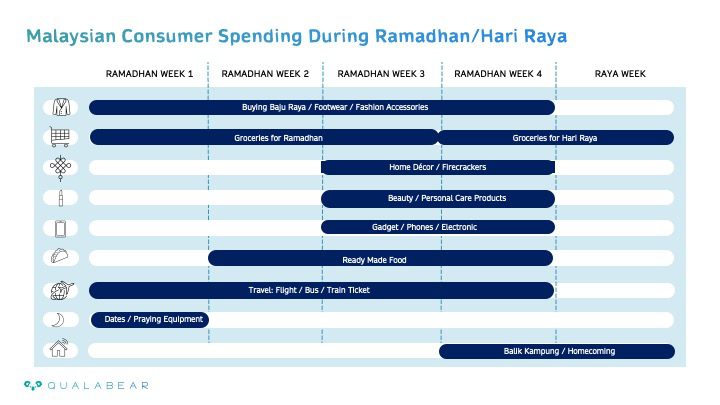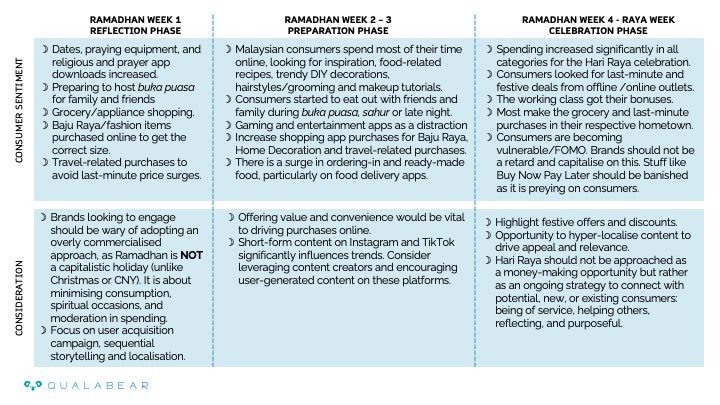The Ramadhan is here. Nobody cares about COVID-19 anymore, but it has been replaced with widespread geopolitical conflict, ongoing bombardment of Gaza, Israel-affiliated brand boycott, social and environmental crisis, new tax, and depreciating Ringgit, which will undoubtedly impact the way people approach Ramadan and Hari Raya this year.
Malaysia is a Muslim-majority country, with 63.5% Muslim population. This is a crucial time for marketers, brands, and SMEs to show respect and understanding of Ramadhan’s/Hari Raya’s values and current consumer sentiment.

Refresher: Ramadhan
What: Putting the slim back into Muslim. Hehe. Ramadhan is the “holy month of fasting” or “bulan puasa.” During the fasting hours from sunrise to sunset, Muslims do not eat, drink, or refrain from bad speech and behaviour, sexual relations, or any particular vices and temptations. Muslims are also encouraged to focus on charity, Quran recitation, voluntary prayers, etc.
Keywords: Compassion, generosity, empathy, self-control, humility.
When: The Islamic Hijri calendar shifts each year based on moon-sighting (known as tengok anak bulan in Malay). The Quran was first revealed to our Prophet Muhammad during this month.
Why: Ramadhan is a month-long spiritual reflection and renewal. It is supposed to purify the soul and demonstrate solidarity with the poor and needy. It reminds us of human frailty, reduces our attraction to worldly life, and reconnects us with the afterlife.
Who and Where: It is compulsory for all Muslims around the world, except those who are ill, travelling long distances, kids, etc. Parents would even encourage their kids to start as early as seven years old.

Key Uniqueness / Symbolism for Ramadhan
- Sahur: The pre-dawn meal before starting the day’s fast.
- Fasting is compulsory and one of the pillars of Islam.
- Breakfasting/Buka Puasa: The meal to break your fast. Due to the crazy Arabisation in Malaysia, some call it Iftar. In the first week of Ramadhan, most of the time is spent with family members. But from the second week onwards, some opt for breakfast with colleagues, friends, etc. – somewhat like a reunion and a catch-up session at a restaurant, buffet at a hotel, etc.
- Dates: A fruit commonly associated with Ramadhan during breakfast. Yusoff Taiyob~~
- Bazaar Ramadhan: They are temporary markets set up during Ramadan for the Malaysian community to eat and shop, just like a night market (but more expensive. Tea O Ais can cost you RM9). Roti John, Murtabak, and most kuih (depending on region) are the most popular and well-sought food items.
- Mosque: The place of worship for Muslims. It is usually packed during Ramadhan and symbolises community and collective worship.
- Terawih: The special prayer after Isyak ranges from 7 to 20 rakaat (sets). Muslims are encouraged to do it at the mosque every night. You will get more good deeds (or Pahala) as you approach the end of Ramadhan.
- Moreh: It is the meal that some mosques/houses would serve after Terawih prayers.
- Zakat: or charity. Muslims are encouraged to share their wealth with the less fortunate through Zakat (can deduct tax, too) and do community service. Malaysians would donate food to the mosque, their neighbour, family members, etc. This month, there’s also a movement to support local/Muslim products.

What is a typical day for Malaysian Muslims during Ramadhan?
4 am – Sahur
- Wake up and prepare for Sahur.
- The meal prepared is usually basic: rice + 2-3 dishes. The emphasis is on a nutritious, filling meal.
- Reheat from buka puasa is common.
6 am – Sunrise
- Start of Puasa
- Most Malaysians spend time gaming, social media, or sleeping after Sahur and preparing for work, school, kids, etc.
8 am – Work/School
- Some businesses and schools may reduce operating hours or close entirely during the day.
- Muslims would start early, skip lunch hour and go home early (instead of the typical 9am to 5pm, it could be 8am to 4pm)
12 pm – Short Break
- Most would either take a short nap after prayer or continue working.
- Most also browse the Internet for places to eat, recipes, and other information. Online shopping is also common.
4 pm – End of work/school
- Most would visit the bazaar to buy food, usually kuih / delicacies.
- Mother would usually start cooking for the family.
7 pm – Break Fasting
- Breakfasting – rice + 3-5 meals + dates + kuih/local delicacies.
- There are two styles:
- The most popular is eating heavy food, then performing Solat Maghrib and other activities.
- Eat a light meal during buka puasa, pray, and then only eat a heavy meal.
- Hosting is common for close family/friends/neighbours.
- Breakfasting with friends/family is more common from the second week onwards.
- Most would use national TV channels/radio for buka puasa announcements.
9 pm – Terawih
- Special prayers range from 7 – 20 rakaat (sets).
- Afterwards, most would spend time catching up on homework, doing house chores, watching TV, gaming, etc.
- Outings with family/friends after Terawih are common: restaurants, parks, mosques, etc.
12 pm – Sleep / Nightly prayers
- The majority would sleep late during Ramadhan due to routine disruption.
- Some would take the opportunity to do nightly prayers (known as Qiamulail) to get extra pahala.

Challenges during Ramadhan
- Ramadhan is a major disruption to Muslim’s usual routines. Muslims would need to wake up 2 hours earlier; they can’t eat during the day, and that means their energy is tanked. Early mornings and late evenings are suddenly filled with all the activities usually done throughout the day. There is so much to do, so little time.
- Being hangry is real, man: dehydration, inability to focus, smelly breath, headaches. And you need to push through for a whole month as it’s business as usual. The majority are, of course, okay with this. But there are a few who thinks they are the “main character” who would become highly retarded, selfish and the whole world needs to tip-toe around them – you would hear news like teachers asking non-Muslim kids to eat inside a toilet during school recess, politicians banning the stores/school canteen from operating at certain hours etc.
- Religious police will also be active this month. What a waste of public funds. The Jabatan Agama people would raid the restaurants/houses, etc., that sell food to Muslims who are not fasting during the day. Advice for the Non-Muslims (especially Chindian): eat at the non-Halal restaurant. If the religious police still stop you, splash some bak kut teh on their kopiah.

Refresher: Hari Raya
What: Raya literally means big. There are two Hari Raya in the Muslim calendar, and this is the biggest annual celebration, Hari Raya Aidil Fitri. The wannabe Arab would call this “Eid-Al-Fitr”.
Keywords: Togetherness, celebration, reward, forgiveness, start anew.
When: 1 Syawal in the Hijri calendar, at the end of Ramadhan.
Why: It marks the end of Ramadhan, which Muslims celebrate as a reward for a month of fasting.
Who and Where: It is celebrated by all Muslims regardless of age or location in Malaysia. It is also a turn-based RPG game; if the husband is celebrating Raya in his hometown this year, it is the wife’s turn next year.

Key Uniqueness / Symbolism for Hari Raya
- Balik Kampung (homecoming): In the final week of Ramadhan, most Malaysians who live and work in major cities like Klang Valley, Johor Bharu, and Penang travel back to their hometowns. Depending on their origin, they can spend 2- 24 hours on the road (the traffic is crazy). This is an excellent opportunity for marketers to double down on their radio campaigns. Lately, some have started the “reverse Uno Card trend”, whereby the kampung relatives would travel to Klang Valley to celebrate Hari Raya. Hope it is gaining more popularity this year.
- Cuti Raya: Most would take 5-10 days of leave during Hari Raya.
- Gotong-Royong: aka the Teamwork required to clean the house, revamp its exterior/interior, prepare food, etc., to celebrate Hari Raya. Usually, males are responsible for laborious work, i.e., cooking preparation, cleaning the house, painting, etc., while females dominate the kitchen in food preparation / kuih, etc.
- Decorations: Pelita (traditional lantern), lampu liplap (blinking lights), ketupat ribbons, new curtains/sofas, new paint, etc.
- Fireworks: Mercun and bunga api. Kids would play this on Raya eve, first and second Raya. Air Pollution Index go stonk!
- Baju Raya: Muslims wear traditional Malay attire, and since the rise of social media, each family has coordinated themes (e.g., colour, textile, etc.). The mother is usually the key decision-maker for baju raya purchases. Clothing also depends on the origin, with Kebaya Kedah (for the northern region) or Baju Melayu Johor (for the southern area). Marketers must be aware of these nuances if hyper-localisation content is the strategy.
- Solat Raya is a special prayer held on the first day of Raya, around 8-9 a.m. It is usually performed at the mosque and consists of prayers followed by a short sermon.
- Silaturrahim: Or strengthening relationships and togetherness. Hari Raya is like a big reunion, a bonding session with those who work/study in other states with the family/friends in their hometown. It is also an opportunity to introduce new family members.
- Salam Raya is an act of asking for forgiveness for all one’s wrongdoings. The young shake and kiss the hands of the elderly. Phrases like “Selamat Hari Raya, Maaf Zahir Batin” (literal translation is Please forgive my external and internal mistake) are often said during this act.
- Duit Raya: Malaysians also borrow inspiration from Chinese culture; they give money in decorative packets as a symbol of appreciation, love, and contribution. Parents give duit raya to their kids, including smaller kids in the family, relatives, and friends; kids give to their elder parents, etc. Those who are working are expected to give duit raya. Those who are not earning income are not expected to give duit raya.
- Raya Food: Traditional dishes are typically served to the family after Solat Raya and vary widely by geographical location.
- Universal/West Coast: Lemang, rendang, ketupat
- East Coast: Nasi Dagang, Nasi Kerabu, Nasi Minyak, Satay
- North: Rendang Tok, Laksa Penang, Serunding
- South: Lontong, Masak Lodeh, Rendang Hitam.
- Kuih Raya: Pineapple Tart, biskut almond, biskut cornflakes, popia simpul, biskut kacang, brownies, kuih semperit etc
- Visiting Grave: Some families visit their ancestors’ graves, recite the Quran, and clean the site. This is usually done on the first Raya, before or after Raya prayers.
- Ziarah: Or visiting family members. Most would visit close family or nearby extended family on the first Raya. Most would only travel to visit relatives from the second Raya onwards.

What is a typical day for Malaysian Muslims during Hari Raya?
6 am – Sunrise
- Mothers (or females) will wake up earlier to prepare food/get the kids ready.
7 am – Prep for Hari Raya
- Wear the new baju Raya, preparing self and kids.
- Most would make their way to the mosque for Solat Sunat Aiditfitri.
8 am – Solat Sunat
- Most will perform Raya prayers at a nearby mosque.
- Females would usually skip the prayer, opting to help with main meal preparation.
9 am – Main Raya Meal and Salam Session
- During this day, everyone, from the oldest to the youngest member of the family, must seek forgiveness from each other. Kids would line up to shake hands with their parents. Duit Raya is given during this salam session.
- Raya food is served for the family.
- Family taking photos. Muslims would also be highly active on social media from this point onwards.
11 am – Hosting and Visiting Family Members
- The day is followed by enjoying meals and visiting nearby family and friends until late at night.
- Some may visit and clean up their ancestors’ graveyards.
9 pm – Night celebration/hosting
- Some would organise a barbecue/satay session.
- Kids would continue to play firecrackers at night.
- Parents would prepare the kids’ second pair of Baju Raya for tomorrow’s outing.

Challenges during Raya
- The traffic is absolutely crazy. It builds up from the second Raya onwards until the seventh day. The petrol station is full of travellers looking to visit relatives or scour the land for good food.
- As it is a big reunion, the drive to impress and to look good is off-the-chart.
- Before COVID-19, people bought new cars to drive in their hometowns. It is good that the banking industry has tightened up its loan criteria now.
- As with any other celebration, you need to be mentally prepared to get body shamed by aunts/uncles or get asked when you’re getting married/have kids/have new kids.
- The duit raya and the money packet culture put a lot of unnecessary pressure on the low-income groups. Some will not return to their hometown if they cannot give duit raya.
- It might be counterintuitive, but Hari Raya is a nonstop food celebration. Hence, overeating, digestion problems, and stomach-related diseases are common.
- While the majority expressed excitement for the upcoming Hari Raya celebration, most Malaysians felt fearful as they anticipated increased expenses due to the current economic instability and reduced spending power. This indicated a shift towards a more frugal approach to the festivities.
Malaysian Consumer Spending During Ramadhan/Hari Raya


Other Interesting Read
- TGM Global Ramadhan 2023 Survey
- Ramadhan with TikTok Malaysia 2024
- Celebrating Ramadhan in Malaysia and Indonesia 2018 (a bit outdated)
Ending
I have never written any cultural piece, so I wonder how this would pan out. Well, anyway.
My dear Muslim friends, you can’t be slow now. You guys have to fast. Chop chop.

